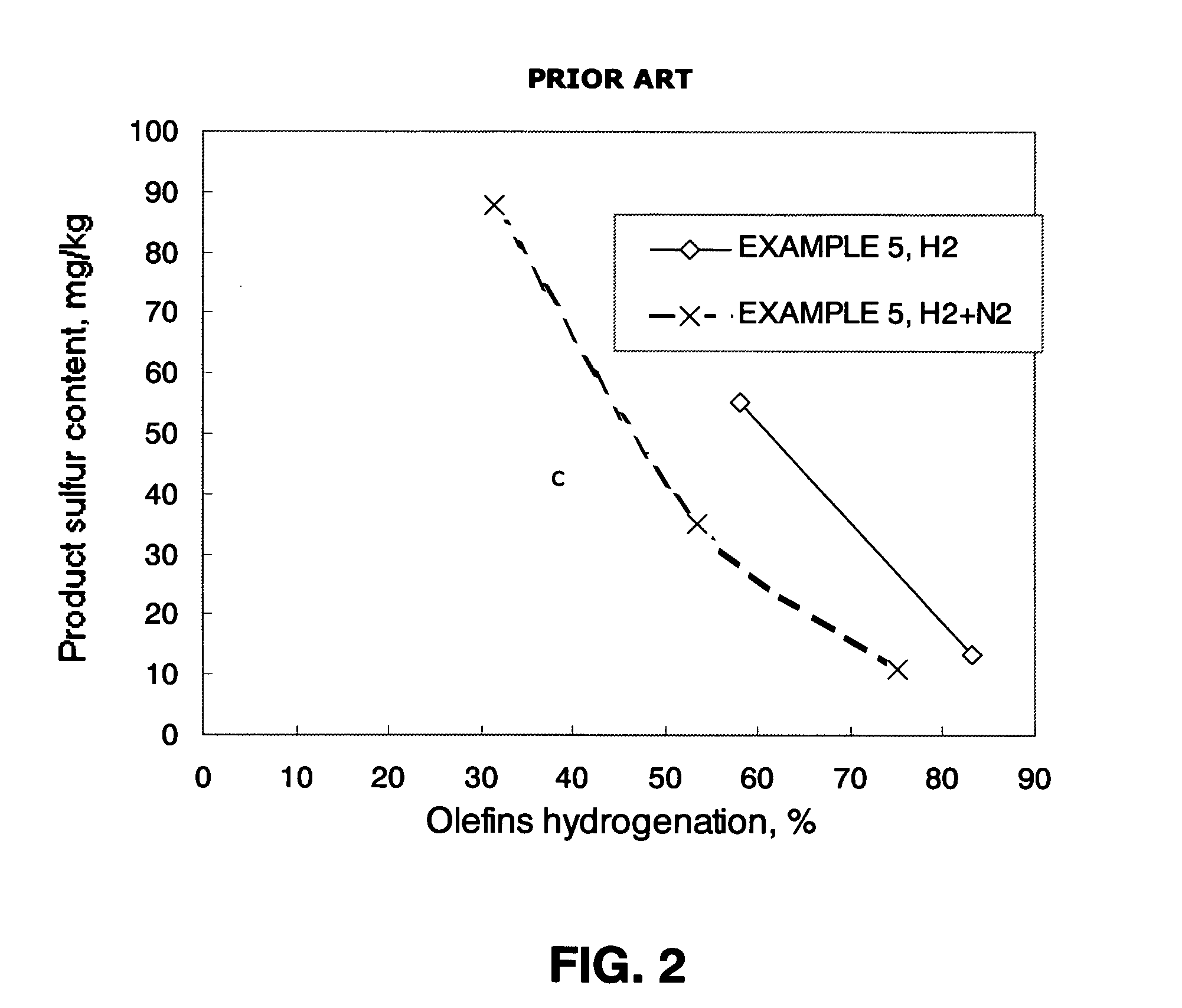Process for selective hydrodesulfurization of naphtha
- Summary
- Abstract
- Description
- Claims
- Application Information
AI Technical Summary
Benefits of technology
Problems solved by technology
Method used
Image
Examples
example 1
[0126] This example pertains to the state of the art. Hydrodesulfurization is carried out by contacting the naphtha charge with the catalyst and hydrogen gas, in two reaction stages.
[0127] The charge was processed in the first stage using a pure hydrogen flow and at a temperature controlled at 255° C. alongside the reactor, with the other conditions fixed as described above.
[0128] Upon removing the H2S from the effluent, the sulfur concentration was 170 mg / kg, and the olefin concentration was 22.3 mass % in the partially hydrodesulfurized naphtha, equal to a 17.4% hydrogenation of olefins.
[0129] Analysis of sulfur speciation showed that only 17% of the sulfur in the partially hydrodesulfurized naphtha corresponds to thiophenic compounds present in the charge, while the remaining 83% are likely mercaptan and sulfide compounds resulting from recombination.
[0130] Next, the partially hydrodesulfurized naphtha was submitted to a second reaction stage under the same process conditions...
example 2
[0132] This Example regards the process of the present invention. The hydrodesulfurization reaction is carried out in two stages, using a flow of hydrogen and an added non-reactive compound (nitrogen) only in the second stage.
[0133] The naphtha charge was processed in the first stage using a pure hydrogen flow and at a temperature controlled at 255° C. alongside the reactor, with the other conditions fixed as described above.
[0134] After the H2S was removed from the partially hydrodesulfurized naphtha, the sulfur concentration was 170 ppm, and the olefin concentration was 22.3 mass %, equal to 17.4% hydrogenation of olefins.
[0135] Next, the partially hydrodesulfurized naphtha was submitted to a second reaction stage wherein the H2 molar fraction was kept at 0.5 while varying the reaction temperature.
[0136] Table 2 shows the results for the sulfur and olefin concentrations obtained during testing.
TABLE 2TemperatureMolar fractionSulfurOlefins° C.H2mg / kgmass %Test 1a2400.52220.6T...
example 3
[0137] This Example regards the process wherein the hydrodesulfurization reaction is carried out in two stages, using a flow of hydrogen and an added non-reactive compound (nitrogen) only in the first stage.
[0138] The naphtha charge was processed in the first stage using an equimolar mixture of N2 and H2 and at a temperature controlled at 272° C. alongside the reactor, holding to the same sulfur content as in EXAMPLES 1 and 2, and with the other conditions fixed as described above. Thus, the sulfur content of the first stage products in the hydrodesulfurization with H2 (EXAMPLE 1 and 2) and EXAMPLE 3 can be considered as equivalents.
[0139] After the H2S was removed from the partially hydrodesulfurized naphtha, the sulfur concentration was 165 mg / kg, and the olefin concentration was 22.5 mass %, equal to 16.9% hydrogenation of olefins.
[0140] Analysis of sulfur speciation showed that 45% by mass of the sulfur in the partially hydrodesulfurized naphtha corresponds to the species pre...
PUM
 Login to View More
Login to View More Abstract
Description
Claims
Application Information
 Login to View More
Login to View More - R&D
- Intellectual Property
- Life Sciences
- Materials
- Tech Scout
- Unparalleled Data Quality
- Higher Quality Content
- 60% Fewer Hallucinations
Browse by: Latest US Patents, China's latest patents, Technical Efficacy Thesaurus, Application Domain, Technology Topic, Popular Technical Reports.
© 2025 PatSnap. All rights reserved.Legal|Privacy policy|Modern Slavery Act Transparency Statement|Sitemap|About US| Contact US: help@patsnap.com


